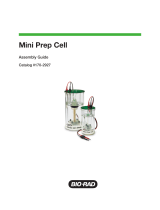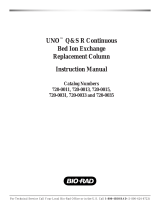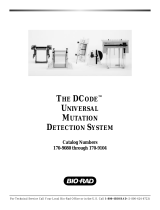Page is loading ...

i 56-2853-00 AE, 2002-12 • p1
instructions
Gradient Mixer GM-1
1. Introduction
The Gradient Mixer GM-1 (120 V, Code No. 19-0495-01,
230 V Code No. 19-0485-01) consists of two identical
reservoirs mounted on a base plate; connection between the
reservoirs is made via a valve. Mounted above the mixing
reservoir is a motor unit which drives a stirrer blade. The
outlet from the mixing reservoir to the column is fitted with
a flow control valve, FCV-1. The Gradient Mixer is
conveniently supported on a laboratory stand. Capillary
tubing, 2 m, is also supplied.
2. Safety
Warning!
When using hazardous chemicals, all suitable protective
measures such as protective glasses, must be taken.
3. Unpacking
Unpack the equipment carefully and check the contents of
the carton against the packing list.
4. Description
THE BASE PLATE (11)* is a precision machined
polypropylene block on which the reservoir cylinders (7) are
mounted.
Sealing between the base plate and the cylinders is provided
by O-rings (8).
THE RESERVOIR CYLINDERS (7) are straight
polymethylpentene tubes threaded at one end and with air
inlets at the other end. Each cylinder has a capacity of 300 ml
and is graduated to 250 ml at 25 ml intervals to give a rapid
check of the volume of liquid remaining in the reservoirs.
The mixing reservoir carries the motor unit (1, 2) and the
other reservoir is fitted with a snap-on lid (3).
THE MOTOR UNIT (1, 2) consists of a fully encapsulated
low speed 250 or 300 rpm synchronous motor mounted in
polypropylene housing. A phasing condensor ensures that
the direction of stirring is always the same and that the
stirrer blade (6) lifts the liquid entering the mixing reservoir.
The motor unit is supplied for operation from 100–120 or
220–240 V AC, 50 or 60 Hz.
THE STIRRER BLADE (6) is secured to the motor axle by a
nylon screw (5). It is unnecessary to remove the screw to
release the stirrer blade.
THE CONTROL VALVE (12) regulates the flow of liquid
between the two reservoirs. It is fully open when screwed out
one complete revolution from the closed position.
THE FLOW CONTROL VALVE (18) is a needle valve
designed for shut-off as well as flow control. The valve
nipple accepts capillary tubing 1.6–1.9 mm o.d. Eluent flow
is regulated with the large knob (A). The line on this knob
and the markings on the valve housing can be used as a flow
rate guide. The valve can thus be opened to a previously
determined position to obtain a given flow rate. To obtain
reproducible flow rates the valve should always be returned
to the shut position before setting.
THE STAND MOUNT (21) may be used to support the
Gradient Mixer on a laboratory stand. When not required,
it may be removed from the base plate (11) by unscrewing
the retaining knob (20).
5. Installation
Connection of tubing to the flow control valve
1. Cut the tubing cleanly at a 45° angle.
2. Remove the screw cap and slip it over the tubing.
3. Remove the rubber cone with the help of the metal
stopper.
4. Push the tubing through the rubber cone until it projects
about 1 cm.
5. Seat the tubing in the nipple. Slide the cone along the
tubing, into the nipple.
6. Finger tighten the screw cap.
* Numbers refer to the enclosed Spare Parts drawing.

i 56-2853-00 AE, 2002-12 • p2
Dismantling the Gradient Mixer
The reservoir cylinders (7), control valve (12) and flow
control valve (18) may be removed from the base plate by
unscrewing them. To remove the stirrer blade (6) from the
motor unit (1, 2), unscrew the nylon screw (5) a few turns.
It is not necessary to remove the screw completely. The lid of
the motor unit should not be removed.
6. Operation
Operating the Gradient Mixer
1. Close the control valve (12) and flow control valve (18)
and pour the required amount of starting solution into
the mixing reservoir. The graduations may be used as an
approximate guide to the volume of liquid in the
reservoirs.
2. Mount the motor unit (1, 2), with the stirrer blade (6),
on the mixing reservoir.
3. Open the control valve (12) slightly so that the channel
between the reservoirs fills with solution and a small
amount of liquid emerges into the other reservoir. Close
the control valve.
4. Pour the gradient-forming solution into the empty
reservoir until the liquid levels in the two reservoirs are
nearly the same. The level in the mixing reservoir should
be slightly higher than the level in the other reservoir to
avoid a step at the beginning of the elution.
5. Open the control valve (12) fully, one complete
revolution, start the motor and begin the elution by
opening the flow control valve (18). If a pump is used to
control the eluent flow, the flow control valve (18)
should be fully open, one complete revolution .
The Gradient Mixer will give linear ionic strength gradients
and reproducible, but non-linear, pH gradients. The exact
shape of the pH gradient obtained will depend on the buffer
salts used and the ionic strengths and pH’s of the buffer
solutions. The use of gradient elution in ion exchange
chromatography is described in the booklet “Ion Exchange
Chromatography – principles and methods.”
7. Maintenance
Warning!
When using hazardous chemicals, all suitable protective
measures such as protective glasses, must be taken.
Cleaning
Ordinary laboratory detergents may be used to clean the
gradient mixer. Enzyme detergents are recommended for
removing protein aceous contaminants. The mixer, including
the stirrer blade but not the motor unit, may be autoclaved
at 121 °C for 20 min.
Caution!
Do not autoclave the motor unit or drain the motor in
strong detergents.
8. Technical specification
Mixing chamber 300 ml
volume
Environment +4–40 °C
20–95% relative humidity
Material of Polymethylpentene,
wetter parts Polypropylene, glass fibre reinforced
polypropylene and fluororubber.
Chemical resistans The wetted parts are resistant to
aqueous and organic solvents
commonly used in ion change
chromatography and solutions
containing inorganic and organic
acids, alkalis and alcohols.
Power requirements 100–120 VAC or 220–240 VAC,
50–60 Hz
Power consumption 7 VA
Safety standards This products meets the requirements
of the Low Voltage Directive (LVD)
73/23/EEC through the harmonized
standards EN61010-1 and EN60742.
Note: The declaration of conformity is valid for the
instrument when it is:
• used in laboratory locations,
• used in the same state as it was delivered from
GE Healthcare Bio-Sciences AB
except for alterations described in the
user manual,
• used as a “stand alone” unit or connected to other CE
labelled GE Healthcare Bio-Sciences AB instruments or other
products as recommended.

i 56-2853-00 AE, 2002-12 • p3
DetaiI No. Designation Code No. Material No. per pack
1 Motor unit (complete with 18-1121-66 A* 1
detail Nos. 3, 4, 5) 110 V
2 Motor unit (complete) 230 V 18-1121-67 A* 1
3 Lid 19-0452-01 B 1
4 Switch
5 Screw
6 Stirrer blade 19-0455-01 A 1
7 Reservoir cylinder 19-0457-01 D 1
8 O-ring 19-0364-01 E 2
11 Base plate
12 Control valve (complete) 19-0462-01 A* 1
13 Knob
14 Screw
15 O-ring
16 Foot 19-7320-01 F 4
17 O-ring 19-0680-01 E 10
18 FIow controI vaIve FCV-1 19-0049-01 A* 1
(complete)
19 Sealing plug 19-0039-01 E 5
20 Retaining knob 19-0489-01 G 1
21 Stand mount 19-0463-01 H 1
22 Tubing 19-0040-01 I 10 m
23 Stopper 19-0752-01 H 10
* material of main component.
Materials
A Polypropylene
B Polyvinylchloride
C Polyamide
D Polymethylpentene (TPX09)
E Fluororubber
F Polyurethane
G Superpolyoxymethylene
H Stainless steel
I Polyethylene
9. Spare parts
Caution!
Only spare parts approved or supplied by
GE Healthcare Bio-Sciences AB may be used
for maintaining and servicing of Gradient Mixer GM-1.
The figure indicates the correct locations of the different
parts of the Gradient Mixer. For replacements please order
according to the spare part list below using the appropriate
code number.

i 56-2853-00 AE, 2002-12 • p4
to order:
Asia Pacific Tel: +852 2811 8693 Fax: +852 2811 5251 Australasia Tel: +61 2 9899 0999 Fax: +61 2 9899 7511 Austria Tel: 01 576 0616 20 Fax: 01 576 0616 27 Belgium Tel: 0800 73 888 Fax: 03 272 1637
Canada Tel: 1 800 463 5800 Fax: 1 800 567 1008 Central, East, South East Europe Tel: +43 1 982 3826 Fax: +43 1 985 8327 Denmark Tel: 45 16 2400 Fax: 45 16 2424 Finland & Baltics Tel: +358 (0)9 512 3940
Fax: +358 (0)9 512 1710 France Tel: 0169 35 67 00 Fax: 0169 41 9677 Germany Tel: 0761 4903 401 Fax: 0761 4903 405 Italy Tel: 02 27322 1 Fax: 02 27302 212 Japan Tel: 81 3 5331 9336 Fax: 81 3 5331 9370 Latin
America Tel: +55 11 3933 7300 Fax: +55 11 3933 7315 Middle East and Africa Tel: +30 2 10 96 00 687 Fax: +30 2 10 96 00 693 Netherlands Tel: 0165 580 410 Fax: 0165 580 401 Norway Tel: 2318 5800 Fax: 2318
6800 Portugal Tel: 21 417 7035 Fax: 21 417 3184 Russia & other C.I.S. & N.I.S. Tel: +7 (095) 232 0250,956 1137 Fax: +7 (095) 230 6377 South East Asia Tel: 60 3 8024 2080 Fax: 60 3 8024 2090 Spain Tel: 93 594 49 50
Fax: 93 594 49 55 Sweden Tel: +46 18 612 19 00 Fax: +46 18 612 19 10 Switzerland Tel: 01 802 81 50 Fax: 01 802 81 51 UK Tel: 0800 616 928 Fax: 0800 616 927 USA Tel: +1 800 526 3593 Fax: +1 877 295 8102
GE Healthcare are trademarks of General Electric Company. GE Healthcare Bio-Sciences AB Björkgatan 30, SE-751 84 Uppsala, Sweden. GE Healthcare Bio-Sciences Ltd GE Healthcare Place, Little Chalfont,
Buckinghamshire HP7 9NA, England. GE Healthcare Bio-Sciences Corp 800 Centennial Avenue, PO Box 1327, Piscataway, NJ 08855 USA. GE Healthcare Europe GmbH Munzinger Strasse 9, D-79111 Freiburg, Germany.
GE Healthcare Bio-Sciences KK Sanken Building, 3-25-1, Hyakunincho, Shinjuku-ku, Tokyo 169-0073, Japan. All goods and services are sold subject to the terms and conditions of sale of the company within
the General Electric Company group that supplies them. A copy of these terms and conditions is available on request.
Meaning:
Consult the instruction manual to avoid personal injury or
damage to the product or other equipment.
Warning!
The Warning sign is used to call attention to the necessity to
follow an instruction in detail to avoid personal injury. Be
sure not to proceed until the instructions are clearly
understood and all stated conditions are met.
Caution!
The Caution sign is used to call attention to instructions or
conditions that shall be followed to avoid damage to the
product or other equipment. Be sure not to proceed until the
instructions are clearly understood and all stated conditions
are met.
Note:
The Note is used to indicate information important for
trouble free or optimal use of the product. Should you have
any comments on this instruction, we will be pleased to
receive them at:
GE Healthcare Bio-Sciences AB
S-751 82 Uppsala, Sweden
Warranty and liability
GE Healthcare Bio-Sciences AB guarantees that the product
delivered has been thoroughly tested to ensure that it meets
its published specifications. The warranty included in the
conditions of delivery is valid only if the products has been
installed and used according to the instructions supplied by
GE Healthcare Bio-Sciences AB.
GE Healthcare Bio-Sciences AB shall in no event be liable for
incidental or consequential damages, including without
limitations, lost profits, loss of income, loss of business
opportunities, loss of use and other related exposures,
however caused, arising from the faulty and incorrect use of
the product.
Produced by Wikströms, Sweden 1021611, 12.2002
Printed matter. Licence 341 051
10. Important user information
/




